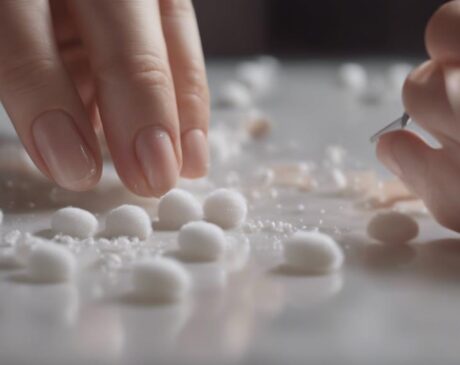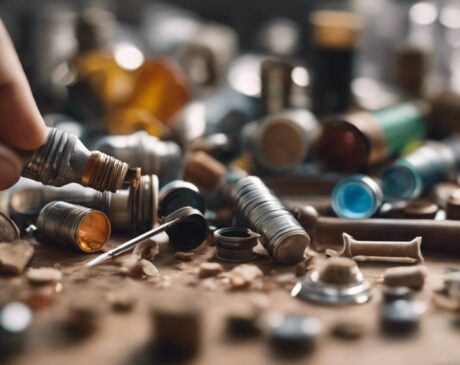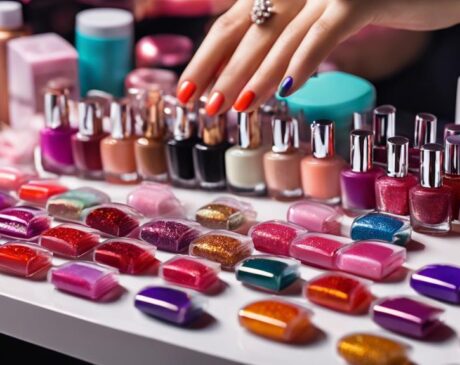How Do You Know if Gel Is Undercured?

Identify undercured gel by a sticky or tacky layer post-curing, dull texture, or quick chipping. Properly cured gel lasts weeks without issues. Risks of undercured gel include premature chip, uneven texture, and susceptibility to breakage. Visual indicators are sticky layer, dull appearance, or uneven color. Test curing using UV light testers; color-changing gel indicates full cure. To prevent undercuring, apply thin layers, cure correctly, and avoid moving hands during the process. Ensuring proper curing is crucial for durable results.
Key Takeaways
- Sticky or tacky layer on nails post-curing indicates undercured gel.
- Dull, uneven texture and quick chipping are signs of undercuring.
- Gel may discolor or change appearance if not cured properly.
- Use UV light testers to ensure gel cures effectively.
- Prevent undercuring by applying thin, even layers and curing correctly.
Signs of Undercured Gel

How can you identify if gel is undercured? One of the key indicators of undercured gel is a sticky or tacky layer left on the nails after curing. This residue is a clear sign that the gel has not been fully cured and requires further attention. Additionally, undercured gel may appear dull or have an uneven texture compared to properly cured gel, which usually has a smooth and glossy finish.
Another way to detect undercured gel is by observing the durability of the manicure. If the gel polish chips, peels, or lifts shortly after application, it is likely that the gel was not cured correctly. Properly cured gel should last for weeks without any signs of wear or damage.
Furthermore, undercured gel may also lead to discoloration or changes in the appearance of the nails over time. Keep an eye out for any unusual changes in the color or texture of the gel, as these could be indications of undercuring.
Risks of Undercured Gel
The improper curing of gel nails can pose various risks to both the appearance and health of the nails. When gel polish is undercured, it may lead to premature chipping, peeling, or dullness of the manicure. Additionally, undercured gel can result in an uneven texture, affecting the overall smoothness of the nail surface. Beyond aesthetic concerns, undercured gel nails can also pose health risks. The uncured gel may trap moisture or bacteria underneath, potentially leading to infections or nail damage. Furthermore, improperly cured gel may not provide sufficient strength and protection to the natural nails, increasing the likelihood of breakage or thinning. To ensure the longevity and health of your nails, it is essential to properly cure gel polish to achieve optimal adhesion and durability. By understanding the risks associated with undercured gel, you can take proactive steps to maintain beautiful and healthy nails.
Visual Indicators of Undercuring

Improperly cured gel nails can exhibit specific visual indicators that suggest undercuring has occurred. One common sign is a tacky or sticky layer on the surface of the gel after curing. This tackiness indicates that the gel has not fully cured and hardened. Additionally, undercured gel may appear dull or have a cloudy appearance instead of the glossy finish typically associated with properly cured gel nails. Another visual indicator of undercuring is when the color of the gel appears uneven or streaky, suggesting that the gel layers have not bonded properly during the curing process. Furthermore, if the gel shrinks away from the edges of the nail or starts to lift prematurely, it is likely that undercuring has taken place. By being vigilant and recognizing these visual cues, nail technicians can ensure that gel nails are cured properly, leading to longer-lasting and more durable manicures.
Testing Gel Curing Properly
To ensure proper curing of gel nails, it is essential to employ reliable testing methods. One innovative approach is the use of a UV light tester specifically designed for checking the curing effectiveness of gel products. These testers emit a specific wavelength of light that reacts with photoinitiators in the gel, causing it to change color if the curing process is incomplete. By placing the tester under the lamp during the curing process, users can easily determine if the gel is curing properly based on the color change observed.
Another method involves using a gel polish that changes color when fully cured. This color-changing gel polish eliminates any guesswork, as it transitions from one color to another once fully cured under the lamp. This visual indicator provides a clear signal that the gel has undergone the necessary curing process. By incorporating these innovative testing methods into your gel nail application routine, you can ensure that your gel nails are cured properly, leading to longer-lasting and more durable results.
Preventing Undercured Gel

Effective curing of gel nails can be ensured through proper techniques and attention to detail. To prevent undercured gel, it is crucial to follow specific guidelines during the curing process. Firstly, always apply gel polish in thin, even layers to promote uniform curing. Thick layers are more likely to result in undercured gel due to inadequate exposure to the curing light. Additionally, ensure that each layer is cured for the recommended time using a high-quality LED or UV lamp with adequate wattage. Insufficient curing time can lead to soft, sticky layers that are prone to smudging and lifting. Furthermore, proper hand positioning inside the lamp is essential to guarantee that all areas receive adequate light exposure. Encourage clients to avoid moving their hands during the curing process to prevent any uneven curing. By adhering to these best practices and maintaining precision throughout the gel application and curing process, you can effectively prevent undercured gel and achieve flawless, long-lasting results.
Frequently Asked Questions
Can Undercured Gel Cause Damage to the Natural Nail?
Undercured gel can potentially cause damage to the natural nail due to improper adhesion and longevity issues. Ensuring proper curing times and techniques is crucial to prevent such damage and maintain the nail's health.
What Are the Potential Health Risks Associated With Using Undercured Gel Products?
Using undercured gel products can lead to potential health risks, such as allergic reactions, skin irritation, and nail damage. Proper curing is vital to avoid these issues and ensure the safety of clients.
How Can Undercured Gel Affect the Longevity of a Manicure or Pedicure?
Undercured gel affects the longevity of manicures and pedicures by causing premature chipping, peeling, and dullness. Incomplete curing compromises adhesion and durability, leading to shorter wear time and unsatisfactory results for clients seeking lasting nail enhancements.
Are There Any Specific Tools or Equipment That Can Help Ensure Proper Gel Curing?
To ensure proper gel curing, utilizing tools like LED or UV lamps designed for gel polishes is essential. These devices provide the necessary light wavelength for optimal curing, promoting lasting manicures and pedicures.
Can Environmental Factors, Such as Temperature or Humidity, Impact the Curing Process of Gel Products?
Environmental factors, like temperature and humidity, play a crucial role in the curing process of gel products. Variations in these conditions can affect curing times and product performance, emphasizing the need for controlled settings to ensure optimal results.




